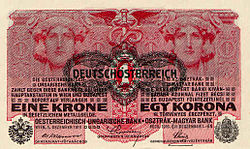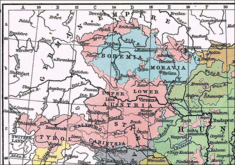- German Austria
-
For other uses, see Austria (disambiguation).
German Austria
Deutsch-ÖsterreichRump state after the collapse of Austria-Hungary ← 
←
1918–1919  →
→
 →
→
 →
→
 →
→

Flag Coat of arms Provinces claimed by German Austria, with the subsequent border of the First Austrian Republic outlined in red Capital Vienna Language(s) German, Czech, Polish Religion Roman Catholicism Government Republic President of the Constituent National Assembly - March 5, 1919 to
December 9, 1920
Karl SeitzChancellor - October 30, 1918
to July 7, 1920
Karl RennerLegislature Reichsrat - Upper house Herrenhaus
(House of Lords)- Lower house Abgeordnetenhaus
(House of Deputies)Historical era Interwar - Abdication of Charles I November 11, 1918 - Republic declared November 12, 1918 - Reichsrat claims
all CisleithaniaNovember 22, 1918 - Treaty of St Germain September 10, 1919 - Ratified by Reichsrat October 21, 1919 Currency Austro-Hungarian krone, overprinted with Deutschösterreich; subdivided into 100 heller 
Republic of German Austria (German: Republik Deutschösterreich or Deutsch-Österreich) was created following World War I as the initial rump state for areas with a predominantly German-speaking population within what had been the Austro-Hungarian Empire, without the Kingdom of Hungary, which in 1918 had become the Hungarian Democratic Republic.
German Austria claimed an area of 118,311 km², with 10.4 million inhabitants including the current area of the Republic of Austria and other German-speaking areas of the former Austrian Imperial lands (Cisleithania) of Austria-Hungary. These included South Tyrol and the town of Tarvisio, both now in Italy; southern Carinthia and southern Styria, now in Slovenia, and Sudetenland proper and German Bohemia (later also part of Sudetenland), now in the Czech Republic. At the time all areas were German majority speaking regions. In practice, however, its authority was limited to the Danubian and Alpine provinces of the old Habsburg realm--almost all of what is now Austria.
Contents
History
In Habsburg Austria-Hungary, "German Austria" was an unofficial term used to describe areas of the empire inhabited by ethnic Germans. With the impending collapse of the empire in late 1918, ethnic German deputies to the Cisleithanian Austrian parliament (Reichsrat) last elected in 1911 sought to form a new rump state of German Austria. It declared a "provisional national assembly of the independent German Austrian state" and elected Franz Dinghofer of the German National Movement, Jodok Fink of the Christian Social Party, and Karl Seitz of the Social Democratic Workers' Party as assembly presidents. Karl Renner was chosen as chancellor of Austria. The assembly included representatives from Bohemia, Moravia, and Austrian Silesia who refused to adhere to the new state of Czechoslovakia which had been declared on October 28, 1918.
On November 11, 1918, Emperor Charles I relinquished power and, on November 12, German Austria was officially declared a republic. The provisional national assembly drafted provisional constitution that stated that "German Austria is a democratic republic" (Article 1) and "German Austria is a component of the German Republic" (Article 2). Later plebiscites in the provinces of Tyrol and Salzburg yielded majorities of 98 and 99% in favor of a unification with Germany. On November 22, the national assembly officially laid claim to all ethnic German areas of Cisleithania. However, the Allies of World War I opposed such a move and German Austria was largely powerless to resist the forces of Italy, Czechoslovakia, and the Kingdom of Serbs, Croats, and Slovenes from seizing territory.
On September 10, 1919, Chancellor Karl Renner signed the Treaty of Saint Germain and it was ratified by the national assembly on October 21. According to its provisions, the name of the republic was changed from "German Austria" to "Austria" and any efforts for the country to unify with Germany were banned. Article 88 of the treaty, sometimes called a "pre-Anschluss attempt", states that "the independence of Austria is inalienable otherwise than with the consent of the Council of the League of Nations." [1] Likewise, in the Treaty of Versailles dictating the terms of peace for Germany, there was a prohibition of unification. With these changes and the settling of Austria's frontiers, the era of the Federal State of Austria, sometimes called the First Austrian Republic, began.
Subdivisions
History of Austria 
This article is part of a seriesEarly History Hallstatt culture Noricum Marcomanni Samo's Realm Carantania March of Austria Babenberger Privilegium Minus Habsburg era House of Habsburg Holy Roman Empire Archduchy of Austria Habsburg Monarchy Austrian Empire German Confederation Austria-Hungary World War I Assassination of Franz Ferdinand World War I Interwar Years German Austria First Republic of Austria Austrofascism/Federal State of Austria Anschluss World War II National Socialism World War II Post-war Austria Allied-occupied Austria Second Austrian Republic
Austria Portal
German Austria originally consisted of nine provinces (Provinzen) including:
- Upper Austria (Oberösterreich), all of the current Austrian state of Upper Austria plus the Bohemian Forest region (Böhmerwaldgau) now in the South Bohemian Region of the Czech Republic
- Lower Austria (Niederösterreich), all of the current Austrian state of Lower Austria plus German South Moravia (Deutschsüdmähren), now divided between the Czech regions of South Bohemia, Vysočina, and South Moravia
- German Bohemia (Deutschböhmen), areas of western Bohemia that were later part of Sudetenland from 1938–45, now part of the Czech Republic
- Sudetenland proper, i.e. the historical Czech regions of northern Moravia and Czech Silesia (Austrian Silesia)
- Styria (Steiermark), most of historical Styria including the current Austrian state of Styria and the north-eastern part of the Slovenian informal region of Lower Styria.
- Salzburg, all of the current Austrian state of Salzburg
- Carinthia (Kärnten), all of historical Carinthia including the current Austrian state of Carinthia, the Slovenian unofficial region of Carinthia, the Slovenian municipality of Jezersko and the now Italian communes of Tarvisio, Malborghetto Valbruna and Pontebba
- German Tyrol (Deutschtirol), most of historical Tyrol including the current Austrian state of Tyrol and the present day Italian province of South Tyrol, but not the province of Trentino
- Vorarlberg, all of the current Austrian state of Vorarlberg
Several German minority populations in Moravia, including German populations in Brünn (Brno), Iglau (Jihlava), and Olmütz (Olomouc) also attempted to proclaim their union with German Austria but failed. The areas now outside of the current Republic of Austria often had significant non-German minorities and occasionally non-German majorities and were quickly taken by troops of the respective countries they were to eventually join. On the other hand, ethnic Germans in the western part of the Kingdom of Hungary that formed a majority in the area known as German West Hungary and agitated to join to Austria were successful and the area became the state of Burgenland, with the notable exception of the region around Ödenburg which was also intended to be the state capital, but due to a very contentious plebiscite, remained part of Hungary. The only other part of the former German counties of 'Burgenland' in the Kingdom of Hungary also not to become part of the Austrian Republic due to the treaty was Preßburg which went to Czechoslovakia.
Anthem
Despite the prohibition on the use of the term German Austria, the republic's unofficial national anthem from 1920–29 was "German Austria, you wonderful country" ("Deutschösterreich, du herrliches Land") with words penned by then Chancellor Karl Renner, signer of the Treaty of Saint Germain.
See also
References
Categories:- Former republics
- Former countries in Europe
- States and territories established in 1918
- States and territories disestablished in 1919
- 1919 disestablishments
- German Austria
Wikimedia Foundation. 2010.




